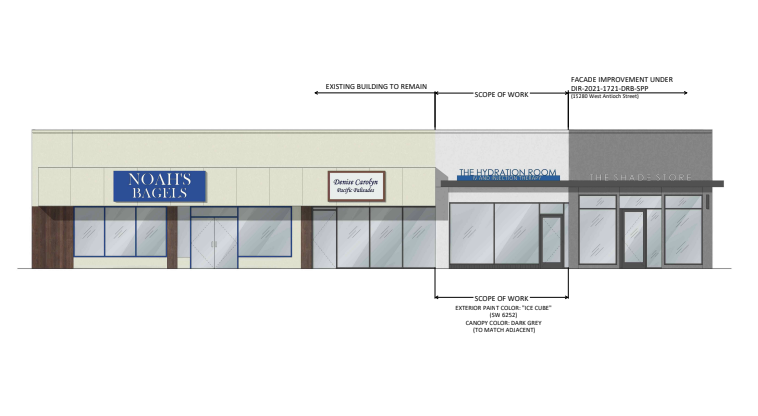
The Pacific Palisades Design Review Board heard the revised plans, via Zoom, for The Hydration Room’s store on Antioch, located next to Denise Carolyn clothing in the former Coffee Bean and Tea Leaf space. The hearing will continue on September 22.
The new store’s proposed floor plan is 545 square feet, which is 20 percent of the building that houses Denise Carolyn, Noah’s Bagels and the former Robeks.
DRB members said the store’s proposed sign was too large per the town’s Specific Plan, but City Planner Nick Vasuthasawat argued that the sign was correctly figured because although the building is divided into four stores, it is just one building.
He noted that the building, which is across from the Village Green, is also a corner building, which means it can have a larger sign.
DRB members reminded him that if the sign is for the building, then it should include all the individual stores. They rejected the idea that an interior store should be able to have a larger sign because it is located in a “corner” building.
DRB members were also concerned about the change of use from a commercial retail space to a proposed medical facility and wondered if this would be an appropriate use of the previous retail space.

This is an example of the lounge. This image was found on The Hydration Room website.
A resident wrote Circling the News on September 1, “DRB doesn’t rule on use, but I haven’t seen if there is going to be a public hearing. Does this require a conditional use permit of some sort for this type of business? Or is it just considered retail? Typically, when the use is changing, a CUP is required. I can’t imagine that this fits into the same category as Coffee Bean.”
That was a similar question the DRB asked the applicant, Dr. Brett Florie, an osteopath who provides vitamin injections and IV therapies.
Florie’s architects (with the firm SAA) answered this query in an August 11 letter: “A medical building is defined by the Specific Plan as: any building or structure in which more than 30 percent of the floor area is devoted to the examination, diagnosis or treatment of physical or psychological disorders of out-patients.”
The applicant explained that “The proposed Hydration Room Suite will have a total of 134-square-feet for two treatment rooms. This is just less than three percent of the entire building.”
Those dimensions are correct, but only if one uses the total square feet of the building (4,958 sq. ft.) for comparison and not the individual store space.
If the individual store space is used, then about 25 percent is used for medical, not three percent. People continue to receive IV’s while in the lounge space, according to photos from The Hydration Room website. If the lounge space and the examination space are added together, treatment space is closer to 75 percent of the store.
Circling the News visited The Hydration Room’s website, which states there are 15 such stores across L.A, Orange and San Diego Counties.
We perused the different injection therapies from a B12 Boost for $25 to the Skinny Shot Program for $290 (kickstart your metabolism with a series of injections containing B vitamins and amino acids). For $150 ($190 deluxe), one can receive the Hangover IV Therapy (reduce symptoms of dehydration, improve mental recovery, renew your liver and alleviate nausea) or a Wellness Infusion IV Therapy for $205 (reboot your body’s immune system and improve symptoms of fatigue and mood).
In the Harvard Medical School Health blog (“Drip Bar: Should You Get an IV on Demand?”), Dr. Robert Shmerling wrote: “What bothers me is the lack of evidence for an invasive treatment. Yes, an intravenous treatment of fluid is somewhat invasive. The injection site can become infected, and a vein can become inflamed or blocked with a clot (a condition called superficial thrombophlebitis). While these complications are uncommon, even a small risk isn’t worth taking if the treatment is not necessary or helpful.”
Shmerling added, “While the benefits of IV fluids on demand are unproven and the medical risks are low (but real), the financial costs are clear. For example, one company offers infusions for $199 to $399. The higher cost is for fluids with various vitamins and/or electrolytes and other medications. Keep in mind that the fluids and other therapies offered can be readily obtained in other ways (drinking fluids, taking generic vitamins, and other over-the-counter medications) for only a few bucks.”
DRB members were told by a Hydration Room representative that many of the people who visit the facility on Montana Avenue in Santa Monica are from Pacific Palisades and Malibu.
CTN asked the City’s Vasuthasawat on September 1 if there would be a public hearing; if a CUP is required; and if The Hydration Room is considered medical or retail. We’ll update the story when he responds.

City Planning Assistant Nick Vasuthasawat said the use aspect of the project is going to be left to city staff and it is not within the authority of the board to act on the land use.
“This is a director-level determination, so the project can still be approved by the city,” according to a representative from the planning department. “Planning staff will write a Letter of Determination, which may or may not include the DRB’s recommendations. The LOD should be issued in the next two months.”